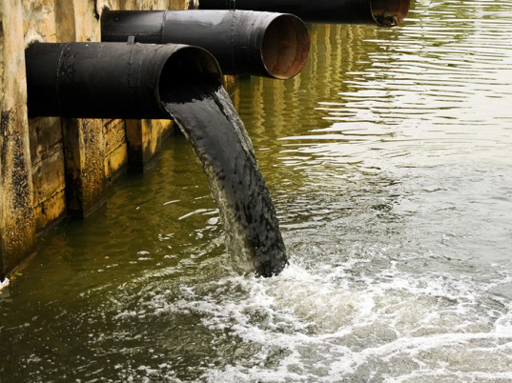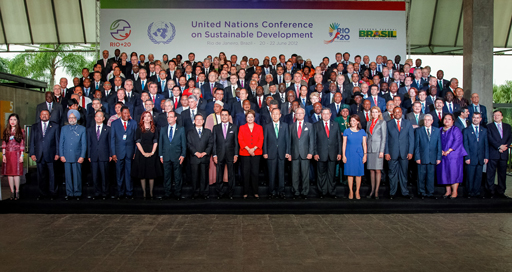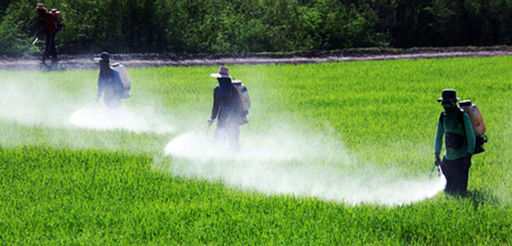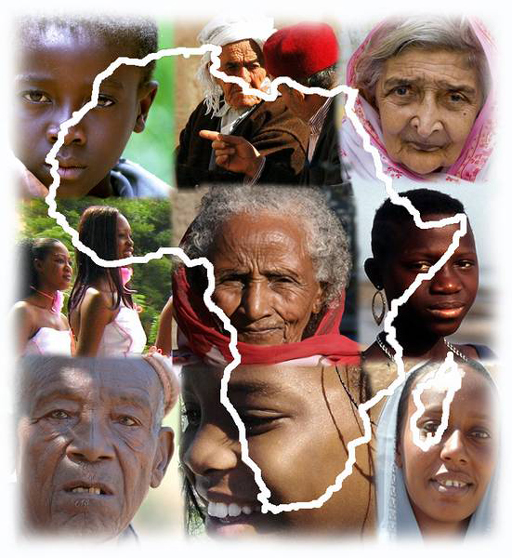Use 'Print preview' to check the number of pages and printer settings.
Print functionality varies between browsers.
Printable page generated Thursday, 25 April 2024, 3:22 PM
Study Session 14 Global Environmental Policies and International Agreements
Introduction
The air, water, weather and climate of the continents of the Earth are interconnected. Human activities across the globe that use natural resources or produce wastes have also become interconnected, particularly with improvements in communication and transport. Many of Ethiopia’s activities both affect and are affected by those of other countries.
International activities and our shared global environment mean that countries worldwide have common interests that need to be addressed through international or global agreements on our environment, trade and business. Such agreements can take place between different countries or more widely through the United Nations. Global environmental policies are internationally agreed goals, principles or procedures used to guide decisions and actions to address specific environmental issues.
In this study session you will learn about global environmental policies and international agreements on environment and health with a focus on water quality, water pollution and use of water resources.
Learning Outcomes for Study Session 14
When you have studied this session, you should be able to:
14.1 Define and use correctly all of the key words printed in bold. (SAQs 14.1 and 14.5)
14.2 Explain the need for global environmental agreements and give examples of issues that need to be addressed at international level. (SAQs 14.2 and 14.3)
14.3 Explain the differences between some types of international agreement. (SAQ 14.1)
14.4 Describe some of the international agreements that relate to climate change and environmental protection. (SAQs 14.4 and 14.5)
14.5 Explain who has responsibility for monitoring implementation of conventions and protocols at international and national levels. (SAQ 14.6)
14.1 Why are global environmental policies needed?
Our world is facing multiple environmental crises, especially from different types of pollution. Pollution from one country can affect a neighbouring country, or even have a global impact. For example, untreated industrial waste discharged into rivers causes pollution at its source but can also affect people who live downstream of the discharge point. In large river systems this can create problems if the river crosses a border with another country and carries the pollution with it (Figure 14.1).

Air pollution from factories, vehicles and wood fires contributes to localised health problems in towns and cities but is also moved around by wind and air currents. These emissions may also contribute to global-level climate change (Salih, 2001; UN-Habitat, 2014). Exporting polluting materials such as hazardous waste from one country to another also raises a concern. There are other ecological crises, such as extinction of animals and plants from the Earth because of destruction of habitats and hunting. Humans’ inability to respond to these various crises leads to a need for global policies to strengthen weak institutions and improve governance.
If you could view the Earth from space (Figure 14.2) you would see that we are all living on one planet and share one global environment. There is a great threat to our survival if humankind continues to damage the environment and if countries do not act together. We have shared responsibilities in caring for current and future generations.

If you had your own business, say a factory producing textiles, and you wanted to operate according to the principles of sustainable development, what would you need to take into account?
In Study Session 3 you learned that sustainable development involves ‘meeting the needs of the present without compromising the ability of future generations to meet their own needs’. So, you would need to think about how your business would affect current and future generations. You would need to take into account the three pillars of sustainability – economy, environment and society. For economy you would need to consider both efficient and effective use of resources. For environment you should aim to use best practices that minimise the environmental impacts of your business. For society you would need to act responsibly and consider livelihoods, human health and well-being, equity, rights and quality of life, not just for current workers and their communities but for the future.
Protecting and managing our global shared resources requires institutions that support collective action (Ostrom, 1990). Such institutions include internationally agreed rules, laws and policies, as well as organisations. International agreements that become policies allow countries to work together in trade and investment and in addressing global concerns such as air pollution, water pollution, managing hazardous wastes, and climate change. All these issues are transboundary in nature, which means that the potential impacts from these events and developments cross national boundaries and affect more than one country.
14.2 Types of international agreement
International agreements take various forms depending on their stage of negotiation and implementation and whether they are intended to detail aims and aspirations or legal rights and duties. In this section we will consider some international agreements developed by the United Nations that have formed global environmental policies.
The United Nations (UN) is an intergovernmental global organisation with 193 member states (including Ethiopia) that promotes and facilitates international cooperation in order to address global concerns such as maintaining international peace and security, solving international problems and encouraging respect for human rights (United Nations, 1945). UN summits and conferences bring together representatives of the member states to discuss transboundary issues (Figure 14.3).

Every member nation has the right to raise its concerns with the UN and can propose items for the agenda of the General Assembly, the UN’s main deliberative body. The self-interest of individual countries and the common interests of the international community can be in conflict. This means international agreement can be difficult to obtain and the process of developing agreements through the UN is highly political, involving many negotiations. Following drafting, discussion and negotiation on their details, many multilateral treaties are adopted by the UN General Assembly and subsequently implemented by the member states.
The terminology for international agreements is complicated. Several words have meanings that overlap and they are not always used consistently. Table 14.1 explains the most usual meanings of various terms used to describe the different types of agreement. Beyerlin and Marauhn (2011) listed 194 of these various agreements that apply internationally.
| Type of initiative | Characteristics |
| Agreement | Can be used generically to mean international agreement in its broadest sense including the widest range of international collaborations. It can also be used more specifically to describe initiatives that are less formal than conventions or treaties and often deal with a narrower range of subject matter. |
| Convention | Generally used for formal multilateral treaties with many parties; normally open for participation by the international community as a whole, or by a large number of states. A convention becomes legally binding on the states that sign up and ratify it. |
| Treaty | Embraces all agreements that are binding in international law; treaties are intended to create legal rights and duties. |
| Declaration | Usually used to declare aspirations rather than to create binding obligations. |
| Protocol | A supplementary document used to add detail or additional rights and obligations to a convention or treaty. |
In order to come into force, an international convention or treaty needs to be ratified, which means individual states agree to be legally bound by it. Once an international agreement is ratified, then that agreement is enforced and monitored internationally. However, this applies only to the states that have ratified the convention and agreed to be bound by its conditions. For example, Ethiopia has ratified two conventions on the control of hazardous wastes, the Basel Convention and the Bamako Convention (described in Section 14.5).
A protocol, containing details of technical and administrative provisions, can be used to create legally binding obligations in international, and subsequently national, law. An example of such a protocol is the Kyoto Protocol on climate change, which was created under the United Nations Framework Convention on Climate Change (see Section 14.4).
Examples of declarations include the Declaration of Human Rights of 1948, the 1992 Rio Declaration on Environment and Development, the 2000 United Nations Millennium Declaration and the 2002 Johannesburg Declaration on Sustainable Development.
Note that UN initiatives are often referred to by the name of the place where they were created: for example, the Bamako Convention was agreed at a meeting in Bamako, Mali; the Kyoto Protocol from Kyoto, Japan, etc.
In the following sections, we will look at some of the main international agreements relevant to environment and WASH, organised by the topics they cover.
14.3 Conventions and agreements on climate change
In 1998 the UN Assembly determined climate change to be a common concern of humankind. The Intergovernmental Panel on Climate Change (IPCC), which is sponsored by the United Nations Environmental Programme (UNEP) and the World Meteorological Organization (WMO), produced evidence in its First Report in 1990 that climate change is a real threat to our environment (IPCC, 1990). More recently, the IPCC formed three working groups that considered three aspects of the problem: the detail of the physical sciences basis for climate change; its impacts on socio-economic systems, their vulnerability and their options for adaptation; and options for mitigation of climate change (IPCC, 2014).
Why is climate change a concern for the global community rather than just a concern for individual countries?
As you know from Study Sessions 9 and 10, climate change is a long-term shift in global weather patterns and average temperatures. At present there is a trend in global warming that is leading to the heating up of the atmosphere and oceans with melting ice at the poles and rising sea level. Temperatures and rainfall have become unpredictable in many parts of the world. Climate change is affecting the environment, water resources and human health and well-being across the world. It is of global concern because it affects the entire planet and because measures to combat climate change need to be implemented globally.
There have been lots of arguments and negotiations between less-developed countries, which are assumed to be most affected because of their currently limited resilience, and industrialised countries, which are blamed for contributing most to global pollution and warming. However, by 1992, there was sufficient scientific and political understanding to persuade 154 heads of state to sign an agreement for the United Nations Framework Convention on Climate Change (UNFCC). This convention has mandated countries that have signed up to it to substantially reduce greenhouse gases (GHGs). For industrialised countries this is on an obligation basis and for developing countries on a voluntary basis. There was universal agreement that each country must develop technology and adaptation strategies to reduce greenhouse gases.
Further discussion after the signing of the UNFCC led to the Kyoto Protocol, which was brought in as a legally binding protocol to monitor the progress of GHG emissions. It was adopted in 1997 and came into force, as of August 2005, among 155 countries. For political and economic reasons, not all states ratify conventions and protocols. In this case the United States and some other countries did not ratify the protocol so it was not legally binding in those countries. This was later followed by the Copenhagen Accordof 2009, a non-binding agreement, under which countries pledged targets to reduce GHG emissions. In 2012 the Doha Amendment to the Kyoto Protocol was adopted so that the protocol could continue.
As you can see, there are many arguments, negotiations and non-binding agreements during the development of international policy and legislation. It can be very difficult to obtain international agreement, especially when it is to be legally binding.
14.4 Conventions on hazardous wastes
What is hazardous waste?
Hazardous waste is waste that is potentially harmful to people or the environment by, for instance, being toxic, explosive, flammable or corrosive. (You learned about the definition of hazardous waste in Study Session 1.)
Hazardous wastes cause a range of damage to humans, such as infections, toxicity to the body, burns to skin and eyes, and cancerous changes in the body and in genetic material. Industrial processes, mining industries and healthcare facilities are the main sources of these wastes.
Waste materials such as toxic chemicals are exported by some countries for treatment or disposal in other countries (Figure 14.4). This is dangerous and is likely to cause environmental pollution and health problems in the receiving countries. The export of hazardous wastes from industrialised to developing countries was highlighted by a case in 1987 where Italian companies exported 18,000 barrels to a local farmer in Nigeria for storage. It was later found that the barrels contained hazardous waste, including polychlorinated biphenyls. The waste was eventually sent back to Italy, but that led to protests in Italy as Italian ports did not want to handle the hazardous material.

Experiences like this Italian case led to increased awareness and recognition of the need for international agreement about the proper handling of hazardous waste. The Basel Convention (Convention on the Control of Transboundary Movements of Hazardous Wastes and their Disposal) was the output of a series of negotiations on the management of hazardous waste. It was adopted in 1989, came into force in 1992, and currently involves 166 countries. The convention provides guidelines for the sound management of hazardous waste using waste optimisation and the assurance of this principle when exporting such wastes to a country.
The Basel Convention encouraged regional agreements on hazardous wastes. Concern over the export of hazardous wastes to African countries led to the Bamako Convention, which has the full title of Convention on the Ban of the Import into Africa and the Control of Transboundary Movement and Management of Hazardous Wastes within Africa. The main aims of the Bamako Convention (UNEP, n.d. 1) are to:
- prohibit the import of all hazardous and radioactive wastes into the African continent for any reason
- minimise and control transboundary movements of hazardous wastes within the African continent
- prohibit all ocean and inland water dumping or incineration of hazardous wastes
The Convention was adopted in 1991 and came into force in 1998. It was originally negotiated by 12 countries of the African Union and has since been ratified by 25 African countries (African Union, 2013).
14.5 Convention on Environmental Impact Assessment in a Transboundary Context
Environmental impact assessment (EIA) is a procedure and set of activities that aim to prevent damage from developments such as the construction of major infrastructure projects. The process of EIA identifies potential impacts and issues at the planning stage of the development initiative and links these to mitigation at the implementation phase. Most EIAs involve at least three stages:
- Collecting data and preparing a written environmental statement that describes the possible impacts of the proposed development.
- Consultation based on the statement.
- Taking account of the assessment findings in the development process with the aim of mitigating the environmental impacts.
The Convention on Environmental Impact Assessment in a Transboundary Context, also known as the Espoo Convention, was adopted in 1991 and came into force in 1997. (Espoo is a city in Finland.) It has the aim of preventing environmental damage and threats from transboundary developments. Examples include irrigation and diversion of watercourses, oil refineries, power stations, radioactive waste processing and storage, large-scale projects for construction, pipelines, bridges and dams. As well as the environmental impacts, developments of this type can also bring changes in community lifestyles and social values.
Generally, an EIA is a means of supporting sustainable development, depending on how the assessment is carried out. The great majority of countries in the world, including Ethiopia, have adopted mandatory regulations. The Espoo Convention was signed and ratified by the Ethiopian parliament and has led to several regulations and proclamations in order for it to be applicable under Ethiopian law.
14.6 Conventions on chemical pollutants
In this section, we will look at two conventions on specific chemical pollutants that are of international concern because of their particular characteristics.
14.6.1 Stockholm Convention on Persistent Organic Pollutants
Persistent organic pollutants (POPs) are chemicals produced by industrial processes, mostly for use as pesticides (Figure 14.5). You may recall from Study Session 8 that POPs are characterised by high toxicity and persistence (lasting for years or even decades before degrading into less dangerous forms). They are also highly mobile in the environment because they may evaporate or dissolve and travel long distances through air or water. They also bioaccumulate in fatty tissues and biomagnify in the food chain. The Stockholm Convention was adopted in 2001 to restrict the production of POPs, eliminating the most dangerous, and to clean up stockpiles and equipment containing POPs. Many POPs contain chlorine in their composition. Examples are aldrin, chlordane, DDT, heptachlor, and hexachlorobenzene. Many of these pesticides are now banned.

What is the difference between bioaccumulation and biomagnification?
Bioaccumulation is the increase of a pollutant in an individual plant or animal because of continued exposure. Biomagnification is the increase of the pollutant in organisms through a food chain. (You learned about bioaccumulation and biomagnification in Study Session 8.)
14.6.2 Minamata Convention on Mercury
This convention’s name comes from the Japanese town that you read about in Study Session 8 where mercury poisoned many of the local population. The convention deals with mercury use and handling with the purpose of reducing and preventing its release and bioaccumulation in the environment including water bodies that might be used for drinking. The ultimate goal is to phase out the release of mercury into the environment. This is a new convention that was adopted in October 2013 and is still open for signing by countries. Ethiopia is a signatory to this convention.
14.7 International declarations
Are declarations legally binding agreements?
Declarations are usually not legally binding agreements. Countries that sign up to declarations are expressing their aspirations in a formal way that requires them to take action.
In addition to formal conventions there are also several international declarations that are relevant to the environment and to WASH.
The UniversalDeclaration of Human Rights was adopted by the UN General Assembly in 1948 and specifies: ‘All people have the right to a standard of living adequate for health and wellbeing of themselves and their family, including food, clothing, housing, health care, and the necessary social services’ (Article 25) (Figure 14.6).
Much more recently, in 2010 the UN recognised the human right to safe drinking water (United Nations, 2010). The UN General Assembly in its Resolution 64/92 recognised ‘the right to safe and clean drinking water and sanitation as a human right that is essential for the full enjoyment of life and all human rights’.

The Declaration of Almaty on primary health care was adopted at an international conference that took place in Almaty (formerly Alma Ata), Kazakhstan in 1978. Primary health care is essential health care that must be accessed by every citizen of the country using locally appropriate technologies and community participation. Access to safe drinking water and sanitation is one of the components of primary health care. Ethiopia has accepted this declaration and has been applying it since 1978.
The United Nations Millennium Declaration (UNMD) was adopted in 2000 by resolution of the UN General Assembly. This was the declaration that announced the Millennium Development Goals (MDGs) for countries to achieve by 2015, which you read about in Study Session 3. The aim was to make progress across the globe on issues of poverty, education, health, hunger and the environment.
Following on from the MDGs, Sustainable Development Goals (SDGs) have been developed by the UN to guide development issues until 2030. There are 17 SDGs to replace the eight MDGs and each is sub-divided into a number of targets. Several SDGs are relevant to the environment and WASH (UNDP, 2015), including:
- Goal 6 Clean water and sanitation: Ensure access to water and sanitation for all.
- Goal 13 Climate action: Take urgent action to combat climate change and its impacts.
- Goal 15 Life on land: Sustainably manage forests, combat desertification, halt and reverse land degradation, halt biodiversity loss.
14.8 Monitoring implementation of international agreements
Each UN Convention has a Secretariat at the UN which monitors the implementation of agreed actions and disseminates the performance of each convention to signing countries. It also provides technical guidance and advice.
A signing country is expected to ratify a convention by designing an act or regulation in the national laws to meet the requirements of the agreed convention. The act or regulation is expected to provide the mechanisms or framework of implementation including monitoring. It provides standards, requirements, institutional implementation arrangements and sets out duties and responsibilities of the competent authority and the stakeholders.
As with all international agreements and legislation, implementation in the various countries is dependent on the capacity of those countries to do that meaningfully. To have real impact in practice, legislation requires political will at a national and local level and sufficient resources for implementation to be achieved. The next and final study session goes on to look at the national regulations and policies relating to water, sanitation and hygiene in Ethiopia.
Summary of Study Session 14
In Study Session 14, you have learned that:
- Countries of the world need international agreements in order to work together. Activities in one country may affect others in terms of damaging the environment.
- There are different categories of international agreements. A convention is a formal overall agreement, while a protocol provides specific details to be implemented. Declarations are non-binding agreements in which aspirations are expressed.
- The UN Convention on Climate Change, and subsequent agreements such as the Kyoto Protocol and Copenhagen Accord, deal with how to protect the environment by reducing greenhouse gas emissions.
- The Basel and Bamako Conventions deal with the movement of hazardous wastes between countries; the Bamako Convention especially aims to stop the import of hazardous wastes into African countries.
- The Convention on Environmental Impact Assessment (EIA) in a Transboundary Context recognises that harm from development does not just occur within a country but across borders. The Convention aims to control such harm using EIAs.
- Some international agreements focus on specific chemical pollutants such as persistent organic pollutants and toxic heavy metals such as mercury.
- UN declarations of relevance to WASH include those on human rights, the right to water and sanitation, and on primary health care.
- Millennium Development Goals were internationally agreed targets for countries on a range of development issues to be met by 2015. These have been followed by the Sustainable Development Goals which set targets for 2030.
- Secretariats at the UN take the lead in monitoring the implementation of UN conventions and protocols. Each signatory country to the convention and protocol is expected to ratify the provisions in a form of national laws (regulations or acts) to be implemented in its territory, so declaring its international commitment.
Self-Assessment Questions (SAQs) for Study Session 14
Now that you have completed this study session, you can assess how well you have achieved its Learning Outcomes by answering these questions.
SAQ 14.1 (tests Learning Outcomes 14.1 and 14.3)
What distinguishes the different types of international agreements developed by the United Nations?
Answer
Conventions and treaties are formal agreements. They are intended to create legal rights and duties but this only happens once member states sign up to and ratify these agreements. Conventions are broad in scope and open for participation by a large number of states.
Declarations usually describe aspirations rather than binding obligations. Protocols are supplementary to conventions or treaties and add details or additional rights and obligations.
SAQ 14.2 (tests Learning Outcome 14.2)
Why are global environmental policies and international agreements needed? In what ways can the activities of one country affect others?
Answer
Our global environment is shared. Interconnections through air, water and human activities mean that one group of people affects and is affected by another group, with effects on the environment that cross national boundaries. We therefore need policies and agreements that enable us to share resources fairly and limit potentially harmful effects of human activities.
Rivers may flow through adjoining countries and the activities in the upstream country can affect the downstream country. This could be pollution in the water or change in volume resulting from water abstraction. You may also have mentioned groundwater; aquifers can extend underneath several countries and be altered by groundwater pollution and over-extraction. Air pollution can spread long distances by the action of wind. Emissions of greenhouse gases into the atmosphere will contribute to global climate change affecting all countries.
SAQ 14.3 (tests Learning Outcomes 14.2 and 14.4)
It is often said that environmental threats don’t respect borders. Explain what this means, giving an example and mentioning an international agreement that aims to tackle such a threat.
Answer
Environmental threats are of international importance because environmental pollution can cross national borders, so cannot be addressed just from one country. An example of a global threat is climate change – greenhouse gases need to be controlled in all countries to tackle the issue of climate change. Both the UN Convention on Climate Change and the Kyoto Protocol aim to tackle climate change by reducing greenhouse gas emissions.
SAQ 14.4 (tests Learning Outcome 14.4)
What is hazardous waste and which conventions address its transboundary movement and disposal?
Answer
Hazardous waste is harmful to people and the environment. It may contain infectious agents; be explosive or cancer-producing; affect genetics; cause fire hazards; be toxic and/or corrosive. The Basel Convention encouraged regional agreements on hazardous wastes. The Bamako Convention bans the import of hazardous wastes into Africa, aims to control transboundary movement of these wastes within the continent, and prohibits incineration and dumping in oceans and inland waters.
SAQ 14.5 (tests Learning Outcomes 14.1 and 14.4)
What is the purpose of Environmental Impact Assessment?
Answer
The purpose of Environmental Impact Assessment, or EIA, is to systematically evaluate potential environmental impacts and issues associated with a given development project. Proposals for actions that will prevent or mitigate the potential impacts can then be prepared.
SAQ 14.6 (tests Learning Outcome 14.5)
Who has responsibility for monitoring implementation of conventions and protocols?
Answer
Each UN Convention has a Secretariat at the UN which monitors the implementation of agreed actions and disseminates the performance of each convention to signing countries. A signing country is expected to provide the mechanisms or framework of implementation, including monitoring when designing an act or regulation in the national laws to meet the requirements of the agreed convention.